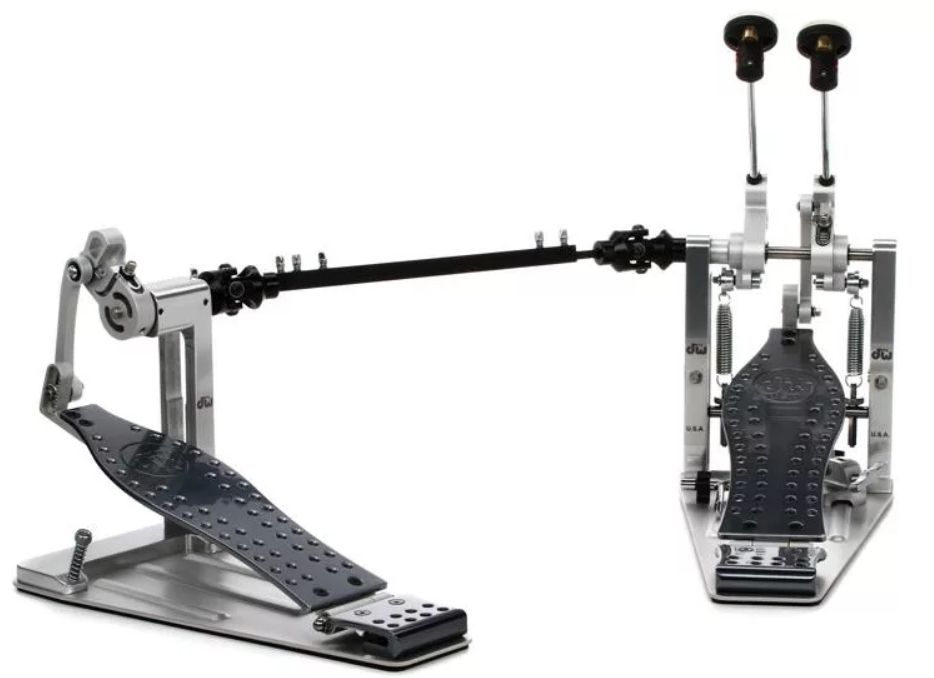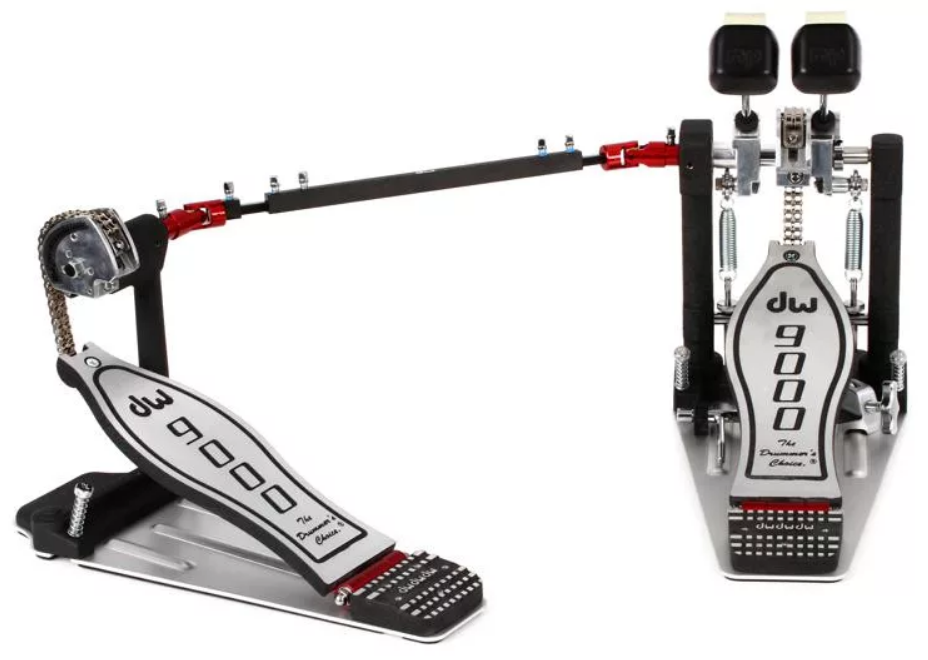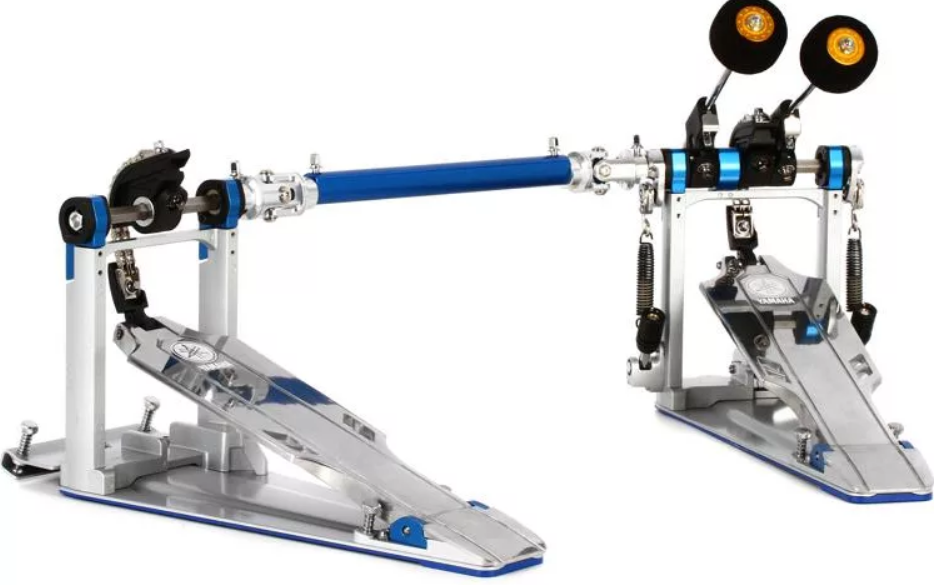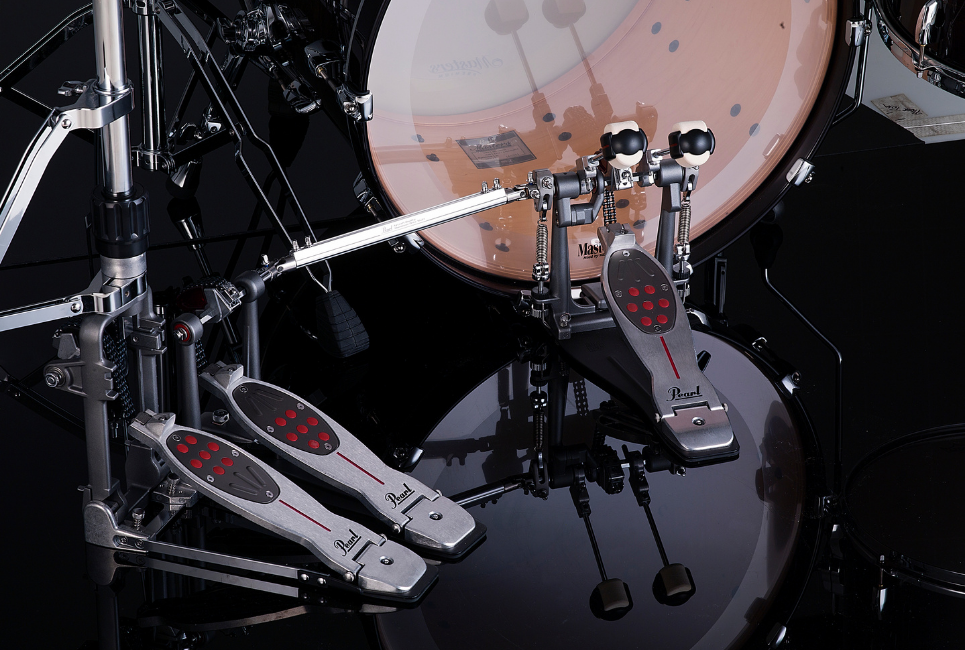- Lights, Camera, and Action: How to Film and Edit a Drum Cover - May 31, 2022
- The Best Wuhan Cymbals: A Comprehensive Buying Guide - May 30, 2022
- Alesis Surge vs Command Compared - April 26, 2022
The double bass is one of the first things that pops up in a drummer’s mind when they think of expanding their rhythmic range. Whether you want to double up on bass rhythms or you feel like working on your foot speed, a double bass pedal is an effective and powerful way of spicing up your drumming routine.
The bass pedal forms a vital link between your limbs and the kick drum, so it’s wise to give it some extra attention. The type of beater, footboard length, and potential adjustment settings will vary according to your playstyle, so make sure these parameters are met before you purchase a new pedal.
I still remember feeling overwhelmed (and pretty much totally confused) the first time I looked up double bass pedal options online. Depending on the type of drive, the beater, and the other customization options, the list of pedals seemed to only get longer the more I looked.
However, over time, I’ve since learned that a good double bass pedal is the one that:
- Fits your budget
- Feels comfortable
- Lasts a long time
Whether you’re a beginner to drumming, or you’re already a seasoned player looking to step up your double bass game, this guide can help you find your next double bass pedal. But before we get to our carefully curated list of pedals, let’s go ahead and first take a look at what a double bass pedal is, how it works, and share a little bit about its history.
My Top 3 Picks
- Pearl Demon Drive P-3002D
- DW 9000 Series Double Bass Pedal
- Yamaha DFP-9C FP 9 Series Chain Drive
What Exactly Is a Double Bass Pedal?
The double bass pedal has undergone many design changes throughout the years, but the main idea behind it still remains the same. It’s the mechanical link that connects your foot to one of the biggest and the loudest drums in your kit: the bass drum.
A single bass pedal, as the name suggests, is a single-foot pedal with a single beater. Most musical styles can get away with a single bass pedal, but in some darker genres of music (such as heavy metal), drummers like to incorporate a lot of staccato style and speedy bass beat parts. And unfortunately, none of these can be played without an additional pedal.
A double bass pedal is essentially two foot pedals linked together with a metal bar. Both pedals are held together by the same shaft that allows you to strike the two beaters individually. They also alleviate the need for a second bass drum, which can save you a substantial amount of floor and trunk space.

The Early History of Double Bass Pedals
The original idea behind double bass can be credited to Louie Bellson, who cobbled together a drum kit with two kick drums for his gig in 1946. The double bass pedals did not hit the market until the seventies, though, when the Sleishman and Zalmer Power Drive train pedals were released.
The 80s and 90s heavy metal and thrash scene would go on to be powered by the ferocity of double bass drumming and some seriously epic drum solos. Companies like Pearl, Tama, and DW quickly rose to fame with their own versions of the twin pedal setups.
In the following years, many improvements were made to drive the technology and momentum transfer techniques. And these changes ultimately laid the foundation for the modern bass pedals we know and love today.
What to Consider When Buying Double Bass Pedals
The first thing you want to deal with when purchasing double bass pedals is the drive configuration. Is it going to be a chain drive or direct? To help you better understand which one you might want, here are some helpful points to allow you to differentiate between them:
- Chain Drives. Chain drives, as the name suggests, use a chain to drive the pedal mechanism. These are typically preferred for their punchy response and overall stability, and the strokes with chain drives tend to feel stronger and focused.
- Belt Drives. Belt drives are very similar to chain drives, except they feel a bit lighter on the foot and are quieter than their counterparts. There’s no right or wrong answer when it comes to having a drive preference, though. It all comes down to your playstyle.
- Direct Drives. Direct drives are typically favored for faster playing styles. They also let you have more control over your strokes, which is a significant benefit to have during speedy parts.
Once you’ve figured out the type of drive, the adjustability options, and the balance, then the footboard length should be the next consideration on your list. You’ll want to make sure your foot has enough room to move around while still fitting comfortably on the footboard.
A good bass pedal will offer you a lot of adjustability options, meaning you can set the spring tension, the distance between the pedals, the height of the beater, and any other specifications according to your preferences.
If you think you may need to expand your kit with additional cymbals or hi-hats in the future, consider getting pedals that allow for an easier upgrade. That way, you can make way for additional space in your kit with mountable stands and pedals.
Major Differences Between Using Double Bass Pedals and Two Bass Drums
If you’re going back and forth between the idea of using a double bass pedal or two separate bass drums, then here are some points that can help ease your decision-making process:
- You can upgrade to a double bass pedal for under $500, whereas buying a new bass drum will certainly cost you a lot more.
- Two bass drums take up quite a lot of space in the kit and storage, whereas a double bass pedal is lightweight and easy to carry.
- You can easily add more cymbals and hi-hats to your setup while using double bass pedals, whereas making space for additional units becomes difficult with two bass drums.
- It’s easier to make mistakes and play out of tune with double bass pedals because the beater hits the drum in two different spots, whereas separate bass drums would be easier to sync.
- Playing really fast double bass with embellishments is easier with double bass pedals since your feet are closer to the hi-hat pedal, whereas with two separate drums, you would have to move your foot farther to reach the hi-hat pedal.
- Miking up a single bass drum that’s running a double bass pedal is quite convenient and easy, whereas if you want to record separate bass drums, you’d be dealing with an extra mic and a barrage of interference issues.
The Benefits of Double Bass Pedals
Here are some of the most notable advantages of double bass pedals:
- First and foremost, the cost of upgrading to a double bass pedal is significantly less than buying two separate bass drums.
- Double bass pedals are lightweight and take only a small place in your storage which makes them a practical option for gigging drummers who travel a lot.
- The intensity and depth of each hit will stay consistent since both the beaters are hitting the same drum.
- Recording double bass and fast rhythmic patterns are much easier with a double bass pedal compared to a two bass drum setup.
- You have the ability to mute and bend the drum head with one beater while hitting with the other, allowing you to create some interesting and complex soundscapes.
The Drawbacks of Double Bass Pedals
If this is your first time switching to a double bass pedal, you might want to keep some of their limitations and downsides in mind, too. These can include:
- Finding the sweet spot for the beaters on the head can take a while to figure out. This position also changes depending on the tension, tuning of the drums, and many other factors, raising further challenges for drummers to deal with.
- You don’t have the option of using different tunings when working with a double bass pedal, an unpopular yet significant downside.
- Double bass pedals with chain drives will wear out more quickly if not maintained properly.
- Many drummers often report experiencing a sloppy sound when playing really fast with double bass pedals. This issue arises due to the beaters hitting the same surface almost instantaneously, one after the other. The drum skin doesn’t get enough time to bounce back to its original state after the first strike, resulting in those out-of-tune strikes.
- Double bass pedal kits don’t look as gigantic or impressive as their counterparts with two bass drums. (Though, to be fair, I personally find this to be more of a limitation rather than a flaw.)
The Best Double Bass Pedals
Buying double bass pedals can be tricky, which is why I want to go ahead and outline the things I looked for before adding one to my list. If they didn’t meet these specific requirements, then I simply didn’t include them.
What Was My Evaluation Criteria?
- Adjustability. The ability to experiment with a lot of different styles of music is a must for most (if not all!) drummers, so having all the basic adjustment options is non-negotiable. The ability to adjust the spring tension, beater height, and distance between pedals are essential for every bass pedal.
- Balance. Spring tension and height between both the beaters is something I like to give special attention to, as well. If any of those parameters are off, then one of your feet will have to work harder to compensate for that inaccuracy. This does not only feel uncomfortable but in the long term can give rise to joint and muscle pains.
- Drive. This decision squarely comes down to your playstyle and sound preference. Want to play really fast double bass? Go with direct drive pedals. Their response will accent your strokes and help you reach high speeds with less effort.
- Cost. High-end pedals do cost a lot, but that doesn’t mean you can’t get a worthy pedal with a smaller budget. There are many double bass pedals from industry giants, such as Tama and Pearl, which offer a huge bang for your buck.
DW MDD MACHINED DIRECT DRIVE

I’m just going to go ahead and start the list out with a really incredible option. That’ll be the new double bass pedal from DW: the MDD (machined direct drive). Built to last and loaded with many incredible design features, this is arguably the best double bass pedal out there.
Not only does it feel smooth to play, but the countered heel plates add an extra element of stability to the whole setup. The foot plates are made from aluminum, making them lightweight and durable. Almost everything on this pedal can be adjusted to create a solid base to play on, too.
The MDD is loaded with many awesome drummer-centric features, such as:
- The Interlocking Delta Hinge
- The Vertical Sliding Spring Adjustment
- The Tri-Pivot Swivel Toe Clamp,
- The Control Beater (with adjustable impact and weight settings)
The fluidity of this pedal comes from the direct drive configuration. Unlike belt or chain drives, there’s no delay in your kicks. The response feels quick and natural in every sense. Furthermore, this pedal performs flawlessly across many music genres.
It doesn’t matter whether you like playing lightning-fast double bass patterns or staccato-style triple strokes, either. This baby can handle pretty much anything you throw at it.
Pros:
- Really great build quality
- Plenty of adjustment options
- Easy-to-use ergonomic design
Cons:
- Is quite expensive
- Fairly heavy
PEARL DEMON DRIVE P-3002D

Many of you might already be familiar with this all-time classic, the Demon Drive from Pearl. Some of the fastest drummers in the world have endorsed this pedal due to its unique base design and build quality. You can even change the size of the footboards to suit your playstyle, which can also make switching techniques mid-play rather comfortable.
This one-of-a-kind double bass pedal uses direct drive and ninja bearings, which are — curiously enough — mainly designed for skateboards. These bearings minimize vibrations and create very low friction, making them one of the fastest double bass pedals in the market.
Pearl knows their way around drums, and it truly shows once you get to play this double bass pedal. This pedal created a seamless link between the feet and the drum skin, improving the playing experience. Even though direct drive pedals are not for everyone’s taste, the sheer number of adjustable features you get with this pedal makes it a popular pick.
Pros:
- Footboard adjustment is incredibly useful
- Direct drive for speed
- Great performance and build quality
Cons:
- Need to take the pedal apart to fit into carrying case
- Direct drive doesn’t suit some drummers
DW 9000 Series Double Bass Pedal

Moving on to the double bass pedal that has been a fan favorite since it first came out, the DW 9000 Series Double Bass Pedal is a strong contender. A lot of drummers stopped hunting for the perfect pedal once they laid their hands on this double bass pedal.
Like the original, the DW 9000 brings loads of incredible features and customization options, all complete in a refreshingly affordable package. The extended footboard that comes with this iteration creates more room for your feet. Even better, it pairs them up with a Tri-Pivot toe clamp system, an EZ Adjust cam, and a non-slip rubber grip base plate for maximum stability.
The world-class hardware and friction-reducing bearing on this pedal give players a comfortable and smooth playing experience. If you aren’t a fan of longboards, consider treating yourself to the standard DW 9000 pedal.
You also get an additional nylon strap with this kit, in case you wanted to switch the chain drive for a snappier attack. Features like the free-floating rotor-drive and rotating swivel springs are what made this pedal so popular, as they let you fine-tune adjustments to your exact preferences.
Pros:
- Longer footboard
- Option of switching to a nylon strap drive
- Stable build and comfortable to play
Cons:
- Some drummers dislike the longer footboard
Yamaha DFP-9C FP 9 Series Chain Drive

The Yamaha DFP-9C double bass pedal is a solid mid-range option for hobbyists and student drummers. It’s designed for fast motions, similar to the 9D model, but features a chain drive instead. This pedal symbolizes the spirit of Yamaha racing, so you know there’s something interesting behind that door.
This is a great choice for drummers who are looking to switch from direct drives to a more stable option. The stability can even be found across the entire pedal due to its swivel spring mounting system. You also get auto-lock springs with stabilizing and anti-skid heel spikes, and an axle-stabilizing bearing chamber wrapped up in a heavy-duty casing.
Other types of drives are subjected to snapping or losing tension under stress, which is why chain drives are sometimes the preferred choice. At the cost of regular maintenance, chain drives offer more stability and stroke energy. If you liked everything about the 9D model but prefer more stability, you definitely should give this pedal a shot.
Pros:
- Sturdy and durable design
- Minimal movement between pedal and bass drum
- Almost no delay during play
Cons:
- Needs regular maintenance
Tama Speed Cobra 910 Twin Pedal

The combination of speed and power was relatively rare back in the day before the Tama Cobra 910 came out. Once the news broke, however, drummers couldn’t stop themselves from getting their hands on this pedal. Serious enthusiasts of drumming love the extra-long footboard, which minimizes effort and maximizes output.
By using a wider base plate and frame, the Tama Speed Cobra 910 takes stability to a whole new level. There’s a three-piece hinge guard block at the heel, which gives you more control over your strokes.
At the heart of the pedal, you find the recessed setting feature, which springs the top of the footboard back and away from the cams. This results in a more organic and smooth motion. The pedal also comes with the Para-Clamp II, which mounts to the bass drum securely without slipping or scratching.
Another eye-catching feature of this pedal is the Swivel Spring Tight tension-locking mechanism. This add-on creates a bit of buffer room for spring movement, allowing for smoother overall action.
Pros:
- Very good for fast playing
- Quite a bit of movement control
- Comes at a fair price
Cons:
- Lacks the necessary durability
- Beaters can be weak
Trick Pro 1-V Bigfoot

Last but not the least, we have the Pro 2-V Bigfoot double bass pedal, a top-of-the-shelf pick from Trick Drums. This pedal has a super snappy response and features a stunningly smooth transmission.
Its fluid mechanics and tight playability might put off some drummers, though, who may otherwise prefer having a synthetic feel and sound. Direct drive pedals tend to be harder to control, which is why they shine the best in fast and aggressive music. If you ask me, the Pro 1-V Detonator has one of the most stable and smooth drive shafts.
The Pro 2-V Bigfoot never seems to succumb to excessive friction or lag, either, which is quite surprising for a pedal in this price range. Adjustment options are another one of the plus points of this pedal, as you’ll get so many to fiddle with.
They have also switched the traditional spring with a compression spring, making it considerably more efficient and durable than the older one. One of the most impressive features of this pedal is that it can be disassembled into two single bass pedals, too, if the need ever arises to play with two bass drums.
Pros:
- Built for speed and quick response
- Independent adjustment for the beater and footboard
- Dual-purpose pedals (two single bass pedals in one)
Cons:
- Other suitable options can be found for the same price
- Left and right pedals occasionally feel inconsistent
My Top Recommendations
- Best Double Bass Pedal Under $500: Tama Speed Cobra 910 Twin Pedal. As we all know, Tama doesn’t need a formal introduction. They wanted to make a double bass pedal for upcoming drummers that drives and holds up like a high-end pedal, yet comes at a fair price tag. If you’re a beginner and don’t want to spend top dollar on bass pedals, you won’t regret going with this option.
- Best Double Bass Pedal for Experienced Players: DW MDD Machined Direct Drive. Exploring the extreme horizons of your strength and skill requires you to be equipped with the right type of gear. It doesn’t matter what’s only our mind, as this pedal is always ready to deliver. Rest assured that with this pedal beneath your feet, you can peacefully work on your chops — without having to worry about stability issues.
- Best Double Bass Pedal for Speed: PEARL DEMON DRIVE P-3002D. The response and freedom of movement you get with this pedal are unmatched. Heavy metal and speed metal drummers have gravitated towards this pedal because it plays so smoothly and handles adjustments like a boss. If you like playing faster or want to develop speed, then the Pearl Demon Drive is the pedal for you.
Expert Tips for Double Bass Drummers
- Be sure to exercise regularly. Ever wonder why some of the best drummers in the world are in peak physical shape? Intricate footwork needs a tremendous amount of energy, focus, and motivation. Staying physically and mentally fit will allow you to progress faster in your pursuit.
- Adjust your pedal properly. Don’t let things hang. If you feel the pedal is loose, the type of drive is not working for you, or the tension is off? Rectify it as soon as possible. You want to spend the majority of your time working with optimum settings in order to maximize your output.
- Practice, practice, practice. Music is one of those endeavors where shortcuts don’t exist. If you want to get into good shape and make a career out of your drum skills one day, then be ready to put in your blood, sweat, and tears.
- Know when to use the “heel up” technique… Faster and louder playing techniques, which require powerful strokes, should use the “heel up” technique. Pressing the pedals down in the middle allows you to strike with more precision and control.
- …as well as the “heel down” one, too. On the other hand, drummers who play less aggressive musical styles (such as jazz) use the “heel up” technique. This method involves keeping both your feet completely on the pedal, letting you utilize the natural leverage of the pedals.
- Master the twenty-five rudiments of drumming. These rudiments are designed to give you a whiff of the nitty-gritty of the drumming world, so don’t miss out on learning them. They will greatly enhance both your rhythmic vocabulary and song-writing process.
- Trust in the beat of the metronome. As a drummer, there’s really no excuse for you to be unfamiliar with keeping time and the various time signatures. If you want to sound tight and natural, then using a metronome during practice and recording sessions is a must.
- Steadily work your way up. You honestly can’t expect to spit out perfect 64ths within days of getting a new double bass pedal, right? Work your way up from smaller time divisions. Then you can gradually work on your speed for better results.
Frequently Asked Questions
Question: What Makes for a Good Double Bass Pedal?
Answer: Keeping all things aside, remember, adjustability is the most important aspect of double bass pedals. You want a pedal that allows you to easily adjust the beater height, spring tension, and other parameters when needed. Balance is also crucial, so make sure your feet sit evenly on the footboard, and you don’t have to stress one foot more than the other while playing.
You also want to make sure that the pedal you get complements your playstyle rather than having you struggle to get the sound right. The type of drive (chain, direct, or belt) will play a vital role in this decision.
Question: How do I Adjust my Double Bass Pedal?
Answer: First and foremost, you’ll want to adjust the height of the beater to address the power you want to get with your foot. Once you find that sweet spot for the beater height, it’s then time to move on to tension settings.
Be sure to adjust the tension to a level that suits your unique playstyle and provides an optimum amount of feedback to your kicks. Last but not the least, fine-tune your beater height once again, as you’ll find that changing the tension will affect the desired height for the beater too.
Question: How Far Should the Beater be From the Bass Drum?
Answer: Ideally, you’re supposed to have the beater at least three inches away from the drum head and at a 45-degree angle. That said, feel free to experiment with that figure and draw your own conclusions.
Question: Do I Really Need a Double Bass Pedal?
Answer: It depends. You probably don’t need a double bass pedal as long as you’re happy with your current setup and sound. On the other hand, if you’re looking to play complex kick drum patterns and boost the dexterity of your footwork, then you should definitely think about investing in a double bass pedal.
Question: Can you Upgrade Single Bass Pedals to Double Bass Pedals?
Answer: Yes, many single bass pedals can be converted into double bass pedals using a right drive shaft. If you’re using a decent mid-range pedal, simply check to see if it can be upgraded.
My Final Thoughts
Going on a hunt for a new double bass pedal can be an adventurous venture in and of itself, especially for first-timers. That feeling of utter joy and excitement when you get your first double bass pedal, though, is a rush like none other. And if you choose my top pick, the DW MDD Machined Direct Drive, then you’ll feel that exhilaration each and every time you play.
Ultimately, the bass pedal you choose has to feel right and complement your playing style. You may not land on the most appropriate choice the first time, and that’s fine. Don’t get discouraged. Instead, use your best judgment to eventually figure out what works best for you — and in no time, you’ll be the speed drummer you always aspired to be!
For some further reading on interesting drum gear, check out the following articles:
How to Find the Best Drum Pedals
The Best Roland Drum Sets – A Guide to Choosing the Perfect Electronic Kit


